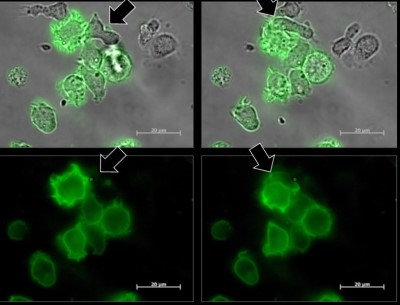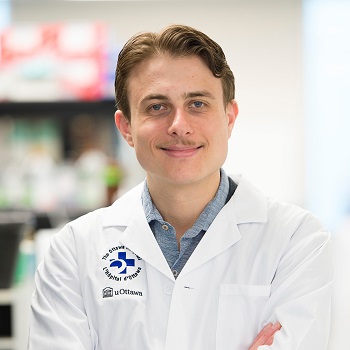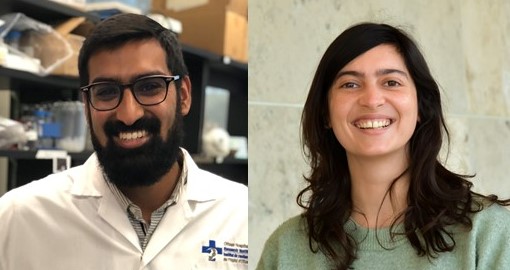 A Natural Killer cell (arrow) turns green after stealing a chunk of a green cancer cell. Cancer cells hijack this process to put Natural Killer cells to sleep and evade the immune system. From Hasim et al., Sci. Adv. 8, eabj3286 (2022). This work is licensed under CC BY (https://creativecommons.org/licenses/by/4.0/).Researchers at The Ottawa Hospital and the University of Ottawa have discovered that a kind of kiss between cells, called trogocytosis, plays a key role in the battle between the immune system and blood cancer cells.
A Natural Killer cell (arrow) turns green after stealing a chunk of a green cancer cell. Cancer cells hijack this process to put Natural Killer cells to sleep and evade the immune system. From Hasim et al., Sci. Adv. 8, eabj3286 (2022). This work is licensed under CC BY (https://creativecommons.org/licenses/by/4.0/).Researchers at The Ottawa Hospital and the University of Ottawa have discovered that a kind of kiss between cells, called trogocytosis, plays a key role in the battle between the immune system and blood cancer cells.
Trogocytosis is a phenomenon by which immune cells, such as Natural Killer (NK) cells, make close contact with another cell and steal a chunk of its membrane. Dr. Michele Ardolino and his team discovered that when NK cells steal membranes from blood cancer cells, a protein called PD-1 comes along for the ride and puts the NK cell to sleep, shutting down their anti-cancer activity.
“NK cells are exceptional cancer killers, and we previously discovered that PD-1 prevents them from working properly,” said Dr. Ardolino, senior scientist at The Ottawa Hospital and assistant professor at the University of Ottawa. “A missing piece of the puzzle is how NK cells produce PD-1, which was surprisingly hard to address. Now we understand why: NK cells do not make their own PD-1, but they steal it from cancer cells! We don’t know exactly why NK cells steal membranes from cancer cells, but it seems clear that tumors hijack the process to put NK cells to sleep and evade the immune system.”
 “We don’t know exactly why Natural Killer cells steal membranes from cancer cells, but it seems clear that tumors hijack the process to put NK cells to sleep and evade the immune system,” -Dr. Michele Ardolino Fortunately, drugs that block PD-1, also called PD-1 inhibitors or immune checkpoint inhibitors, are now routinely used to “wake up” the immune system and help it fight cancer cells. These drugs have significantly improved survival for people with certain kinds of skin cancer, blood cancer and lung cancer, among others.
“We don’t know exactly why Natural Killer cells steal membranes from cancer cells, but it seems clear that tumors hijack the process to put NK cells to sleep and evade the immune system,” -Dr. Michele Ardolino Fortunately, drugs that block PD-1, also called PD-1 inhibitors or immune checkpoint inhibitors, are now routinely used to “wake up” the immune system and help it fight cancer cells. These drugs have significantly improved survival for people with certain kinds of skin cancer, blood cancer and lung cancer, among others.
PD-1 inhibitors were originally developed to wake up the immune system’s T cells. Dr. Ardolino’s research, published in Science Advances, solves a mystery about how PD-1 inhibitors work on NK cells. A better understanding of how these drugs work on different kinds of immune cells could lead to new kinds of immunotherapy for cancer.
Dr. Ardolino notes that this research was possible because of a large team of trainees, postdoctoral fellows and staff.
“There is a great sense of collaboration in research at The Ottawa Hospital and this was instrumental for the success of this project,” said Dr. Ardolino. “We are very lucky to collaborate with physicians invested in performing research to advance patients treatment, such as Dr. Arleigh McCurdy, as well as basic scientists in the Cancer Therapeutic Program, such as Dr. Doug Gray who is a microscopy wiz!”
 Mohamed S. Hasim and Marie Marotel are first authors on the study.Authors: Mohamed S. Hasim*, Marie Marotel*, Jonathan J. Hodgins, Elisabetta Vulpis, Olivia J. Makinson, Sara Asif, Han-Yun Shih, Amit K. Scheer, Olivia MacMillan, Felipe G. Alonso, Kelly P. Burke, David P. Cook, Rui Li, Maria Teresa Petrucci, Angela Santoni, Padraic G. Fallon, Arlene H. Sharpe, Giuseppe Sciumè, Andre Veillette, Alessandra Zingoni, Douglas A. Gray, Arleigh McCurdy, Michele Ardolino. * contributed equally
Mohamed S. Hasim and Marie Marotel are first authors on the study.Authors: Mohamed S. Hasim*, Marie Marotel*, Jonathan J. Hodgins, Elisabetta Vulpis, Olivia J. Makinson, Sara Asif, Han-Yun Shih, Amit K. Scheer, Olivia MacMillan, Felipe G. Alonso, Kelly P. Burke, David P. Cook, Rui Li, Maria Teresa Petrucci, Angela Santoni, Padraic G. Fallon, Arlene H. Sharpe, Giuseppe Sciumè, Andre Veillette, Alessandra Zingoni, Douglas A. Gray, Arleigh McCurdy, Michele Ardolino. * contributed equally
Funding: This research was supported by the Canadian Institutes of Health Research, the Prostate Cancer Fight Foundation, Myeloma Canada, the National Institutes of Health, Sapienza University, Science Foundation Ireland, AIRC, CAAIF and the Government of Ontario. All research at The Ottawa Hospital is also enabled by generous donors to The Ottawa Hospital Foundation.
Core resources: uOttawa Flow Core, OHRI Flow Core, ACVS
About The Ottawa Hospital
The Ottawa Hospital is one of Canada’s top learning and research hospitals, where excellent care is inspired by research and driven by compassion. As the third-largest employer in Ottawa, our support staff, researchers, nurses, physicians, and volunteers never stop seeking solutions to the most complex health-care challenges. Our multi-campus hospital, affiliated with the University of Ottawa, attracts some of the most influential scientific minds from around the world. Backed by generous support from the community, we are committed to providing the world-class, compassionate care we would want for our loved ones. www.ohri.ca
About the University of Ottawa
The University of Ottawa is home to over 54,000 students, faculty and staff, who live, work and study in both French and English. Our campus is a crossroads of cultures and ideas, where bold minds come together to inspire game-changing ideas. We are one of Canada’s top 10 research universities—our professors and researchers explore new approaches to today’s challenges. One of a handful of Canadian universities ranked among the top 200 in the world, we attract exceptional thinkers and welcome diverse perspectives from across the globe. www.uottawa.ca
Media Contact
Jenn Ganton
613-614-5253
jganton@ohri.ca
